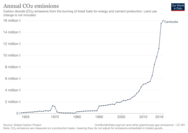Climate change in Cambodia
This article needs additional citations for verification. (November 2021) |

Cambodia is highly vulnerable to the effects of climate change. Extreme weather events will occur more frequently; this includes floods, which already affect 90,000 residents annually, and heatwaves, with Cambodia already having one of the highest temperatures of the world. The temperature has increased since the 1960s by 0.18 °C per decade.[1] It had the 7th lowest CO2 emissions in Asia in 2019.[2]
Climate change is leading to increased drought in Cambodia, which is having major impacts on the Tonlé Sap and Mekong deltas. These water systems are highly important for water, agriculture and fishing in the country. Cambodia's population is impacted by increasing floods, tropical cyclones and waterborne diseases, and is highly vulnerable due to its high rate of poverty.
Greenhouse gas emissions
[edit]
In 2020 Cambodia reported 15.33 mt in CO2 emissions and is responsible for 0.04% in 2019 and cumulatively 0.01% of worldwide CO2 emissions. The per capita CO2 emissions in 2019 were 0.97t since 2013 a big increase in CO2 emissions was observed with an increase of 192.69% between 2013 and 2019.[3][4] 143.84 mt of CO2 emissions have been emitted between 1751 and 2019.[5]
Impacts on the natural environment
[edit]Temperature and weather changes
[edit]
The temperature has increased 0.18 °C per decade since 1980. Cambodia already has one of the highest temperatures in the world with 35 °C being recorded for 64 days a year nationally. These temperatures will rise in all RCP scenarios which could lead to permanent heat stress. The probability of droughts in 2080-2099 will rise from 4% annually to 5-9% under all scenarios.[1]
| Climate change scenario | 2080-2099 |
|---|---|
| RCP 2.6 low emissions scenario | 1.0 °C |
| RCP 4.5 intermediate scenario | 1.8 °C |
| RCP 6.0 peak around 2080 then decline | 2.2 °C |
| RCP 8.5 high emissions scenario | 3.7 °C |
The sub-daily precipitation will likely increase in intensity. Around 90.000 people are annually exposed to flooding in Cambodia, in RCP 8.5 scenario this will increase to 160.000 people annually. A study that was done by the World Bank expects that in 2050 19% of the population will be exposed to flooding.[1]
Water
[edit]
A major climate change issue for Cambodia is the impact it has on the Tonlé Sap lake and Mekong river system.[7][8] Climate change will impact water flow in the country and increase the frequency of droughts.[6][9] Hydropower dams have further exacerbated the issue.[10]
Impacts on people
[edit]Impacts on the Tonlé Sap lake and Mekong will have considerable implications for agriculture and fishing in the country.[7][11] The Cambodian population, which has a high rate of poverty, is highly vulnerable to the impacts of climate change on tropical cyclones, floods and waterborne diseases.[12]
UNICEF ranked Cambodia 46th out of 163 that they assessed on the impact of climate change on the youth. Cambodia was ranked as a high risk country in the report. The youth in Cambodia is already highly exposed to scarcity of water, riverine flooding and vector-borne disease which could worsen with the effects of climate change.[13]
Mitigation and adaptation
[edit]The Cambodian government pledges to reduce emissions by 41.7% in 2030.[14]
See also
[edit]References
[edit]- ^ a b c d "Climate risk country profile Cambodia" (PDF). World Bank. 2021. Archived (PDF) from the original on 2021-09-23.
- ^ "Per capita CO₂ emissions". Our World in Data. Retrieved 2021-11-02.
- ^ "Annual CO₂ emissions". Our World in Data. Retrieved 2021-11-02.
- ^ Ritchie, Hannah; Roser, Max (2020-05-11). "CO₂ and Greenhouse Gas Emissions". Our World in Data.
- ^ "Cumulative CO₂ emissions". Our World in Data. Retrieved 2021-11-02.
- ^ a b Oeurng, Chantha; Cochrane, Thomas A.; Chung, Sarit; Kondolf, Mathias G.; Piman, Thanapon; Arias, Mauricio E. (March 2019). "Assessing Climate Change Impacts on River Flows in the Tonle Sap Lake Basin, Cambodia". Water. 11 (3): 618. doi:10.3390/w11030618. ISSN 2073-4441.
- ^ a b Nachemson, Andrew (23 Sep 2019). "Cambodia's lifeline threatened as Mekong recedes to historic low". Al Jazeera. Retrieved 2022-05-03.
- ^ Vidal, John; Poulton, Lindsay; Randerson, James; Ochagavia, Ekaterina; Brown, Georgia; Aldred, Jessica; Duncan, Max; Cage, Feilding; Louter, Daan. "The Mekong river: stories from the heart of the climate crisis". The Guardian. Retrieved 2022-05-03.
- ^ Daly, Kensey; Ahmad, Shahryar K.; Bonnema, Matthew; Beveridge, Claire; Hossain, Faisal; Nijssen, Bart; Holtgrieve, Gordon (June 2020). "Recent warming of Tonle Sap Lake, Cambodia: Implications for one of the world's most productive inland fisheries". Lakes & Reservoirs: Science, Policy and Management for Sustainable Use. 25 (2): 133–142. doi:10.1111/lre.12317. ISSN 1320-5331. S2CID 219100320.
- ^ Osborne, Zoe (2019-12-16). "Mekong basin's vanishing fish signal tough times ahead in Cambodia". The Guardian. Retrieved 2022-05-03.
- ^ Keeton-Olsen, Danielle; Sineat, Yon (14 Jan 2022). "'Not enough water': Cambodia's farmers face changing climate". Al Jazeera. Retrieved 2022-05-03.
- ^ Davies, Grace I.; McIver, Lachlan; Kim, Yoonhee; Hashizume, Masahiro; Iddings, Steven; Chan, Vibol (January 2015). "Water-Borne Diseases and Extreme Weather Events in Cambodia: Review of Impacts and Implications of Climate Change". International Journal of Environmental Research and Public Health. 12 (1): 191–213. doi:10.3390/ijerph120100191. ISSN 1660-4601. PMC 4306857. PMID 25546280.
- ^ "Children in Cambodia at 'very high risk' of the impacts of the climate crisis - UNICEF". www.unicef.org. Retrieved 2022-03-10.
- ^ Clark, Dan; Joiner, Sam; Bernard, Steven (2021-10-26). "COP26: How every country's emissions and climate pledges compare". Financial Times. Retrieved 2021-11-10.


 French
French Deutsch
Deutsch